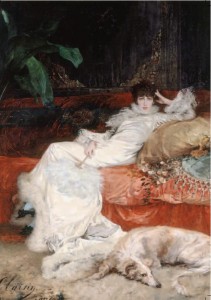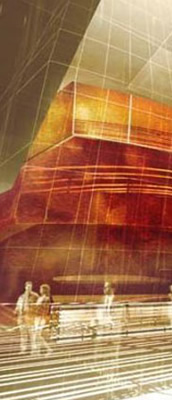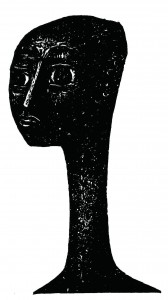Academic Events
Parallel Events
As a result, fourteen new works have emerged, especially created for the project and based chiefly on new technologies, which will be installed in busy public spaces (both in the open and indoors) so that people will come upon them unexpectedly.
The title Visual Dialogues refers initially more to the dialogue of the works to be created with the thematic headings of the conference, and only in a lesser degree to a dialogue among the works themselves, a development which may well ultimately ensue.
The immediate aim of this particular initiative is not that the Athenian public should seek out these works but that they should encounter them by chance in an unexpected way. What is hoped for is an effect of surprise, an arousing of interest, and – why not? – the creation of a public discussion about them.
We believe that this project will enliven, stimulate and revitalize the city, creating nuclei of involvement and poles of attraction in areas much frequented by the public, dispelling the indifference, the indolence, or, conversely, the rush and stressful rhythms that govern the reality of city life, shattering in the end the monotonous daily routine.
If an interactive relationship of the Athenian people with the works to be presented – a stimulation of their interest in contemporary forms of the visual arts and in the dialectical relation of art to scientific, philosophical and sociological discourse – can be realized, then the Visual Dialogues will have achieved its aim.
The fourteen artists taking part in the action and the places where their works are shown are: Christos Apostolakis – Omonia Metro Station, Katerina Apostolidou – ATE Bank (Panepistimiou St.), Makis Faros – Book Arcade, Eleni Kamma – Omonia Metro Station, Αnna Lascari – Syntagma Metro Station, Despina Meimaroglou – Omonia Metro Station, Nikos Navridis – Old Parliament Building, Nikos Papadimitriou – Ermou St. Pedestrian Precinct, Angelo Plessas – Outdoor Parking opposite from the Klafthmonos Square, Alexandros Psychoulis – Monastiraki Metro Station, Yannis Scourletis – Syntagma Metro Station, Vassiliea Stylianidou – Monastiraki Metro Station, Dimitris Tsoublekas – Atrium of the Book Arcade, Kostis Velonis – Information Centre of the Ministry of Culture.
NATIONAL GALLERY, ALECANDROS SOUTZOS MUSEUM
Paris 1900Art Nouveau and Modernism
Treasures from the Petit Palais,
Musée des Beaux-Arts de la Ville de Paris
24/11/1020 – 28/2/2011
 The “Paris 1900: Art Nouveau and Modernism. Treasures from the Petit Palais” exhibition is being staged in parallel with the Athens Dialogues conference and with the support of the Alexander S. Onassis Foundation and the National Bank of Greece.
The “Paris 1900: Art Nouveau and Modernism. Treasures from the Petit Palais” exhibition is being staged in parallel with the Athens Dialogues conference and with the support of the Alexander S. Onassis Foundation and the National Bank of Greece.
The Paris World Fair (Exposition Universelle) of 1900 forms the axis of the show, which spotlights the dominant architectural and artistic trends in Paris as the turn of the 20th century.
In the words of the Director of the National Gallery and professor of Art History, Marina Lambraki-Plaka: “The year 1900 was a watershed. The Paris World Fair, the fifth and last of the 19th century (the others were staged in 1855, 1867, 1878 and 1889 respecitvely) provides a symbolic overview of the transition from the 19th to the 20th century. It was a triumphal summing up of the achievements of the past century in economics and industry, technology, science and culture, but it also looked ahead to a new era of peace, prosperity, progress and cooperation between the peoples of the dawning age. The mass slaughter of the Great War would consign this utopian dream to the history books.
The symbolic culmination of the Belle Époque, the World Fair of 1900 also embodies its paradoxes. In it, Symbolism, the search for the spiritual in nature and art, a pan-European movement which emerged in the late 19th century as a reaction against Positivism and Realism, and the corresponding tendencies of Art Nouveau with its indulgent decorative excess, exist alongside and clash with the austere post-impressionist quests of artists like Cézanne, whose work would soon point the way to Cubism. The last eclectic buildings, too, with their intricately wrought ironwork and wealth of floral designs in carved stone and marble overlap with the first modern constructions using the reinforced concrete that would define 20th-century architecture.
In short, the World Fair of 1900–a reference point for our show, too–was both a farewell and a new beginning.
MUSEUM OF CYCLADIC ART
Vasso Katraki – Ginving Life to Stone
4 November 2010 – 31 January 2011
The exhibition Vasso Katraki–Giving Life to Stone at the Museum of Cycladic Art is organized as a parallel event of the Athens Dialogues conference and is sponsored by the Onassis Foundation. It presents representative works from the entire artistic production of this great engraver −one of the leading figures of twentieth-century Greek cultural expression in its entirety, with international recognition. The exhibition was organized in collaboration with the Vasso Katraki Museum-Center for Engraving Art in Aetoliko, which contributed the majority of the exhibited works.
The selection of the works was based on two axes: the anthropocentric character of her art; and the “relevance” of Vasso’s engraving to the Cycladic marble sculptures of the prehistoric Aegean. These criteria were bolstered by the desire to give the public the fullest possible insight into her total production.
The exhibition brings together woodcuts and wood engravings, engraved stones, drawings, stone moulds, painted pebble, photos and documentation material. This presentation is aptly enhanced by the scholarly essays of the catalogue, which approach the artist’s work from a variety of vintage points, affording a fine glimpse into the personality of the artist and the power of her art.
Katraki’s myths refer to universal and eternal values; her images tie the viewer down, aiming at an ideogram that refers to their essence. Through the various versions of each theme, we observe the thoughts and goals, the aesthetic ideal, the transition to forms of a heightened emotional load. From her first student works to her later, monumental propositions, the perception and rendering of the human figure is the dominant aesthetic-thematic selection of her creation, in which assiduous research and dialogue with Greek art −from prehistory to its popular-traditional expression− play a key role.
The anagoges to and similarities with Cycladic figures are more than potent −her research and interest in Cycladic art, as a fixed area of focus and a source of inspiration, remain intact throughout her creative path. In the elongated, archetypical figures of her compositions, with the abstraction and the deeply wrought simplification of their form, Katraki develops the same vision. She shapes an entire world of symbolic images, expresses a particular stance of life and a social protest, delves in the nucleus of existence and focuses on man’s destiny, balancing passion and exaltation through the evocative antithesis of white and black.
And next to her art, in immediate interdependence with it, is her life; Aetoliko and the lagoon; the War, the Occupation and the Resistance; the exaltations, hopes and refutations −starting points and experiences that determine every attempt of any interpretative approach and analysis of her engraving.
Katraki will dedicate herself to her art, the art of engraving which, thanks to its truth, boldness and poetics, its ethical values, humanitarian-ecumenical content and nonnegotiable view, succeeds to communicate with the audience, corroborating the authenticity and importance of her contribution.
Curators: Giannis Bolis, Art Historian
Maria D. Tolis, Curator, Museum of Cycladic Art
MUSEUM OF CYCLADIC ART / 4 Neofytou Douka | Vas. Sofias & 1 Irodotou / Τ. 210 7228321-3 /www.cycladic.gr










